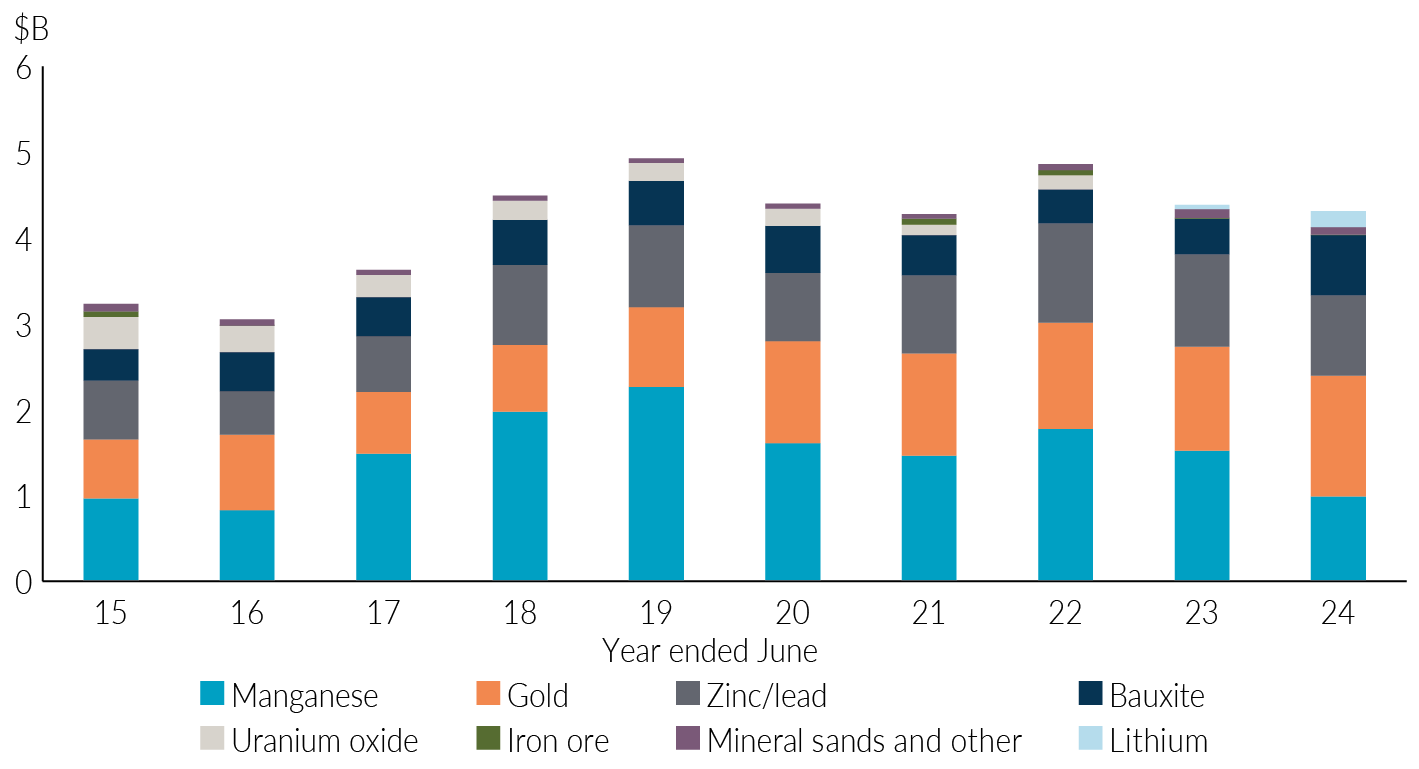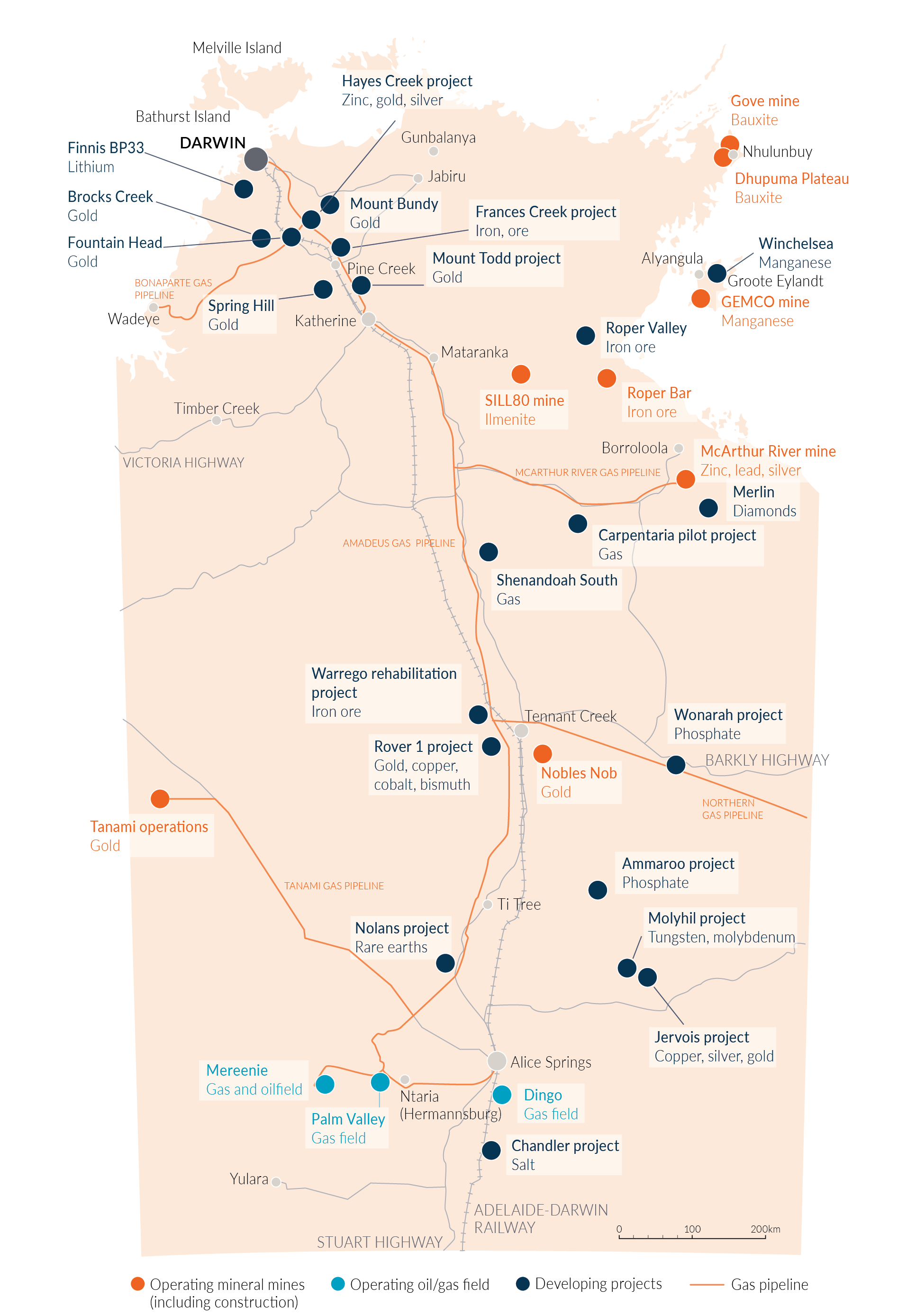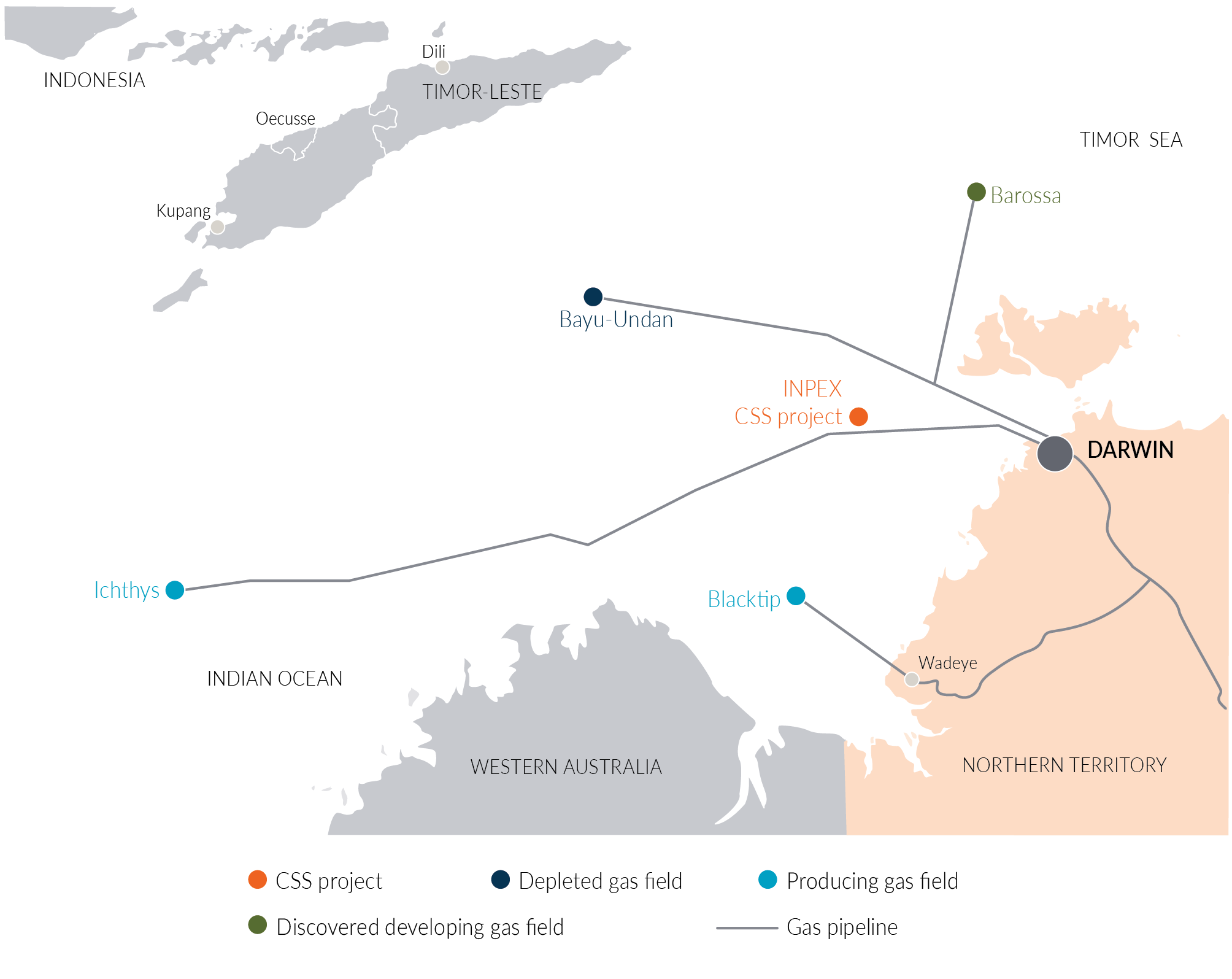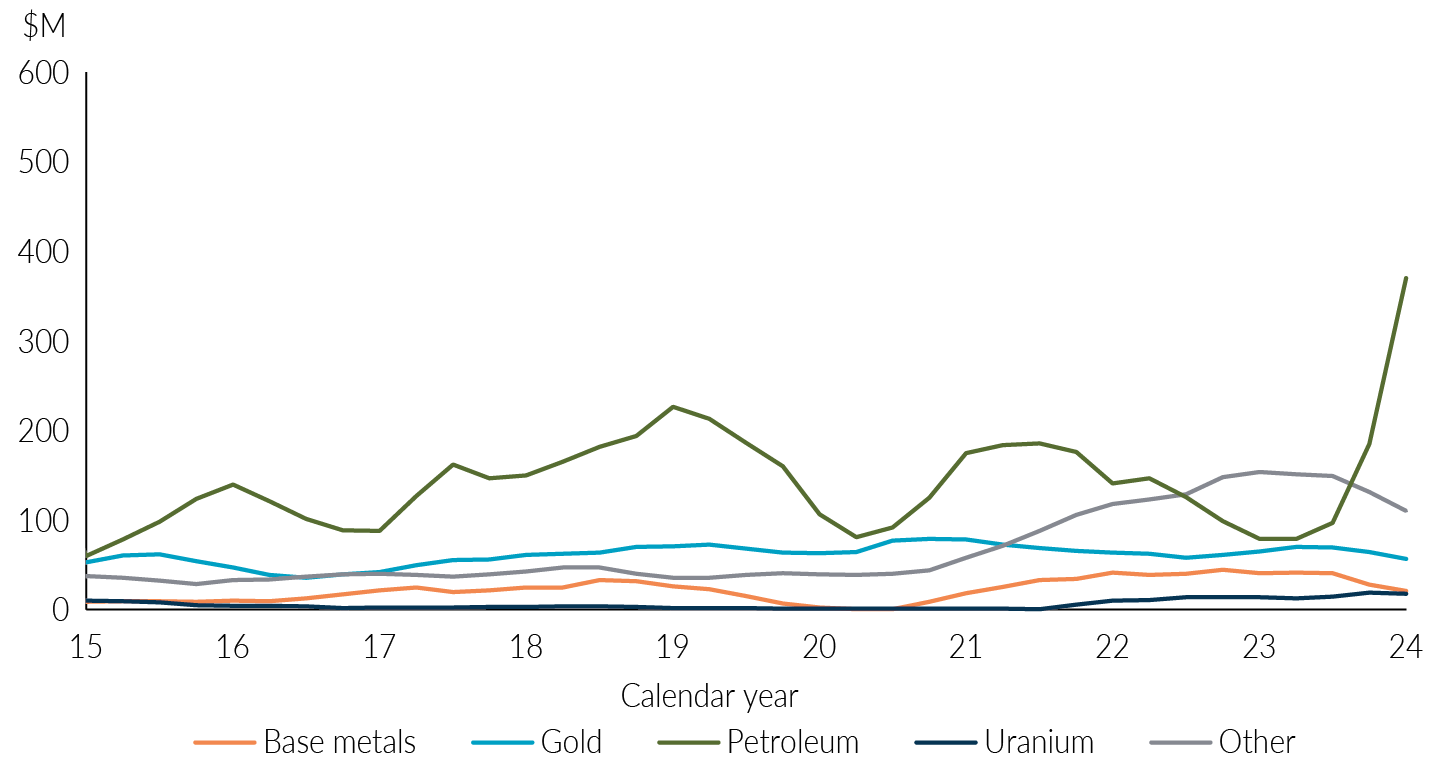Mining and manufacturing
Outlook
In 2024-25, the mining industry’s output is expected to decline due to unexpected maintenance at the Ichthys LNG plant before recovering in 2025-26 as the Barossa project comes on line.
In 2023-24, the mining industry accounted for 24.6% of GSP, making it the largest contributor to GSP. The manufacturing sector accounted for 2.4% of GSP over the same period. Mining employed 4,060 persons in 2023-24, accounting for 2.9% of total Territory employment. The manufacturing industry employed 3,301 persons, accounting for 2.4% of employment. In real terms, the gross value-adding activity of the mining industry increased by 9.5%. Output of the manufacturing industry was broadly flat over the same period.
Mining output is dominated by LNG and metallic minerals. The industry contributes to the Territory economy through international trade, private investment and employment. The Ichthys LNG plant experienced an unplanned outage in 2024, which led to a decline in production. The Bayu‑Undan field continued to produce gas for the Territory’s domestic market over 2024, despite some challenges. Its replacement, the Barossa project, is scheduled for first gas in the September quarter 2025.
Critical minerals such as lithium, copper, nickel, cobalt and rare earth elements are essential for electrification and renewable energy technologies. As countries increase efforts to transition to low-carbon sources of energy, the demand for these minerals is rapidly growing. This presents significant economic opportunities for the Territory, which has the potential to become an important supplier of critical minerals due to its rich mineral endowments. The Territory has resources of 17 critical minerals, of which it currently produces manganese, aluminium (as bauxite), zinc and titanium (as ilmenite).
The implementation of tariffs by the US administration poses direct and indirect risks to the mining sector, with supply chains and investment decisions likely to be impacted (see Northern Territory Economy PDF (1.9 MB), chapter 2 economic growth box 2). The Australian economy is expected to be relatively well insulated from the US tariffs due to the limited volume of direct trade. However, the impacts on Australia’s major trading partners will have flow‑on effects for the national economy. The announcement of additional tariffs in early April 2025 led to increased volatility in commodity and financial markets with considerable uncertainty remaining on the effect of tariffs as the US negotiates new trade arrangements with trade partners.
Minerals production
Most minerals produced in the Territory are metallic, including manganese, gold, zinc and lead, bauxite, ilmenite and iron (Map 1). The Territory also produces non-metallic minerals such as crushed rock, sand, quicklime and gravel.
The value of the Territory’s mineral output was $4.3 billion in 2023-24, a 1.6% decline from the previous year, driven by reduced production of manganese, zinc and lead due to the impact of Cyclone Megan in March 2024, as well as lower zinc prices. This was partially offset by a significant rise in the price for bauxite and gold. The value of mineral output is expected to decline in 2024‑25 to $3.9 billion due largely to a sharp decrease in manganese production before recovering strongly in 2025‑26 to $4.8 billion as manganese production returns to normal and gold production increases.
Manganese
Manganese is an input to steel manufacturing, with production largely driven by global steel demand. In the Territory, manganese is produced at the Groote Eylandt Mining Company (GEMCO) mine, one of the largest manganese mines in the world.
In 2023-24, manganese accounted for 23% of the value of all mineral output sold by the Territory. Over this period, the value of manganese sold fell by 35% to $992.6 million (Chart 4), as mining was suspended in March 2024 as a result of Cyclone Megan. Production is expected to be significantly lower in 2024-25, around 1 million tonnes, due to continued recovery works. Manganese production is expected to return to pre-cyclone levels in 2025-26, at around 5 million tonnes.
Gold
The Territory produces gold predominantly from the Granites mine in the Tanami region. The value of gold sold increased by 15.9% in 2023-24 and accounted for 32.5% of the value of all Territory minerals sold. This was driven by increases in the price of gold and quantity produced.
In 2024-25, the value of gold output is expected to rise reflecting further increases in the price of gold, with production expected to remain broadly steady. The Nobles Nob mine is expected to produce its first gold in mid 2025. In 2025-26, production of gold is anticipated to increase as the Nobles Nob mine moves into full production.
The Tanami Expansion 2 project is expected to begin commercial production in mid 2027 following a capital investment of about $1.8 billion.
Zinc and lead
Zinc and lead are produced at McArthur River mine, located 65 kilometres southwest of Borroloola. The value of zinc and lead sold declined by around 13% to $937 million in 2023‑24. The quantity sold fell by less than 1%, however the quantity produced fell by 7%, suggesting the fall in the zinc price affected mineral production value. Stockpile material was sold to supplement production due to the impact of Cyclone Megan.
In 2024-25 and 2025-26 the value of output sold and volumes produced are anticipated to be steady.
Bauxite
Two bauxite mines operate in the Territory on the Gove Peninsula. The value of bauxite sold in the Territory increased significantly by 67% to $702 million in 2023-24, reflecting record price growth and increased production.
Looking forward, bauxite prices are expected to remain broadly stable, with the volume of production anticipated to decline moderately in 2024-25 and remain flat in 2025-26.
Iron ore
In 2023-24, the value of iron ore sold in the Territory declined by 17.9% to $5.6 million. Iron ore in the Territory was produced mainly at the Peko and Roper Bar mines. The Peko mine went into care and maintenance in February 2024. Production at the Roper Bar mine recommenced in early 2024.
After the Warrego rehabilitation project became operational in October 2024, it dispatched its first shipment of magnetite concentrate in January 2025 before going into administration in April 2025. The Frances Creek mine also exported a shipment of 55,000 tonnes of iron ore fines in April 2025.
Lithium
The Finnis mine opened in October 2022, making the Territory an emerging supplier of lithium. Over 2023, the price of lithium fell steeply due to an oversupply in the market and weak growth in electric vehicle sales. As a result, mining operations at the Finnis mine were suspended in January 2024.
In 2023-24, the Territory produced 209,000 tonnes of lithium concentrate and sold 165,000 tonnes. The value of lithium sold over this period was $189 million, accounting for 4.4% of the Territory’s value of all minerals produced.
A stockpile of lithium fines remains at the Finnis mine site, however no lithium sales were reported in the financial year to date. A restart study is currently underway and on track to be completed in the June quarter 2025.
Uranium
Uranium mining ceased in January 2021 when the Ranger mine closed down, with all inventories sold by June 2022. Rehabilitation of the Ranger mine is currently underway with an estimated cost of $2.4 billion. In February 2025, the Commonwealth approved the mine closure plan for the Ranger mine. Mine rehabilitation will be an ongoing source of activity in the Territory for decades as several mines are nearing the end of their operating lives.
Other minerals
The value of non-metallic minerals sold increased by 5.1% to $73.1 million in 2023‑24. This was driven by increases in producing crushed rock, gravel and soil. The value of mineral output is expected to be relatively stable in 2024-25 and may increase in 2025-26 due to phosphate production. A phased development strategy for the Wonarah phosphate project is being advanced with operations targeted to commence in the September quarter 2025.
Map 1: Current and pending mineral and onshore petroleum operations in the Territory1
1 This map is to be used as a guide only.
Source: Department of Mining and Energy; Department of Treasury and Finance
Oil and gas production
The Territory’s conventional onshore oil and gas is sourced from the Amadeus Basin in Central Australia, with production occurring at the Mereenie, Palm Valley and Dingo fields.
In 2023-24 onshore oil production declined by 20.5% to 110 thousand barrels of oil, and gas production declined by 8.3% to around 12.9 petajoules. A new compressor was commissioned at Mereenie to capture low pressure waste gas and convert it to sales gas. This is expected to increase sales and reduce carbon emissions.
Offshore gas attributed to the Territory is sourced from the Ichthys, Blacktip and Bayu-Undan fields. Previously, gas from the Bayu-Undan field was transported to onshore processing facilities before being exported overseas. However, as the Bayu-Undan field approached depletion, it shifted supply towards domestic consumption. The Barossa project is set to replace Bayu‑Undan and expected to be operational from the September quarter 2025, supplying gas to the Darwin LNG facility for export. The Ichthys field continues to produce gas primarily for export markets. It experienced an unplanned shutdown in 2024-25 and has significant maintenance activities planned for early 2025-26.
Offshore gas from Blacktip is produced for the Australian domestic market, and used for electricity generation in the Territory and sales to the east coast market. Following almost no production from Blacktip from mid-December to mid-March, efforts to enhance production has resulted in an increased production of gas.
The Northern Gas Pipeline (NGP) reverse capability project was completed in August 2024, allowing gas to flow into the Territory from Queensland if required. The main purpose of the NGP is to transmit gas from Blacktip and the Amadeus Basin to the east coast market. In April 2025, the APA Group applied for a pipeline licence to construct a 37 kilometres pipeline from the Tamboran Resources (Tamboran) processing facility in the Beetaloo Sub-basin to the Amadeus pipeline. Construction of the pipeline is expected to commence in September 2025 and be operational in 2026.
Carbon capture and storage (CCS) is the process of capturing greenhouse gases from industrial and energy-related sources and injecting it deep underground for storage. Santos is exploring CCS at the Bayu-Undan field, aiming to store up to 10 metric tonnes per annum (Mtpa) of carbon dioxide using existing infrastructure with the project’s front-end engineering design being 97% complete. A final investment decision is expected in 2026. INPEX is also progressing exploration of CCS opportunities at the Bonaparte Basin. In April 2025, INPEX commenced preliminary front-end engineering design for the CCS project after successfully completing a detailed study and drilling two appraisal wells. INPEX estimates the reservoir can store up to 10 Mtpa of carbon dioxide and has projected injection to occur by 2030.
Offshore petroleum activity near the Territory1
1 This map is to be used as a guide only.
Source: Department of Treasury and Finance
Exploration activity
Exploration activity can be a leading indicator of future development, depending on the outcomes of the exploration work undertaken.
Total mineral exploration expenditure in the Territory declined by 23% to $176 million in 2024, down from $228.5 million the year before. This largely reflects decreased expenditure across ‘other’ minerals and gold, partially offset by an increase in uranium expenditure (Chart 5).
Petroleum exploration activity in the Territory is focused on the Beetaloo Sub-basin and the Amadeus Basin and increased significantly from $78.8 million in 2023 to $369.7 million in 2024. The ABS does not provide a breakdown of onshore and offshore exploration expenditure. Onshore exploration over this period was focused on the appraisal of gas in the Beetaloo Sub‑basin as it aims to move towards commercial production, with offshore exploration expenditure likely to have been from INPEX’s drilling activities to check the suitability of carbon capture in the Bonaparte Basin.
In 2024-25, Tamboran drilled two wells at its Shenandoah South development area, with fracture stimulation of one well completed in February 2025. Results for both wells are expected by mid 2025. In 2025-26, Tamboran plans to drill and test four more wells in the Shenandoah South area as part of its pilot project, which aims to initially deliver 40 tera joules per day of gas. Tamboran is targeting to have first commercial gas available from 2026, with new supporting gas processing and pipeline infrastructure in place.
Empire Energy drilled the Carpentaria 5H well in 2024-25 and plans to fracture, stimulate and flow test this well from June 2025. This well is part of Empire’s Carpentaria pilot project, which includes drilling up to 10 wells and installing a gas processing facility, with first gas sales expected by the end of 2025.
Central Petroleum drilled and commissioned two new wells at Mereenie in 2024-25, with both wells producing commercial gas by early 2025. Approvals for two new wells at the Palm Valley field have been progressing and are expected to increase field production capacity, subject to market conditions and a final investment decision.
Santos is scheduled to drill and test two new wells in the Beetaloo Sub-basin in 2026. The results will add to previous positive flow test results and provide an evidence base for it to progress pilot production activities. In January 2025, Santos and Tamboran executed a memorandum of understanding for a joint study on Beetaloo gas export options through Darwin. In addition, Tamboran has signed a non-binding letter of intent for future gas supply to Arafura’s Nolans project, dependent on a final investment decision.
Value of mineral and petroleum exploration expenditure in the Territory1
1 Moving annual total
Source: ABS, Mineral and Petroleum Exploration, Australia
Manufacturing
Significant manufacturing industries in the Territory include food product manufacturing, fabricated metal and non-metallic mineral product manufacturing.
In 2021, the Territory Government entered a partnership with the Advanced Manufacturing Growth Centre (AMGC) to support the development of advanced manufacturing in the Territory. As part of this partnership, AMGC and the Territory Government have established the Advanced Manufacturing Ecosystem Fund (AMEF) to support local businesses to commercialise products using innovative technology. Since its inception, the AMEF has supported Diverseco, Katherine Joinery, Arctic Installations, Air Tip, Corrosion Instruments, Colemans Printing, Steeline, Warle Construction, Think Water, blueflite, Life h2o Australia, Rise and Wurrba.
To support development of the Territory’s manufacturing sector, the Territory Government is working towards establishing the Middle Arm Sustainable Development Precinct. The focus of Middle Arm will be on enhancing downstream activities, and the project is currently in the planning and concept design phase.




